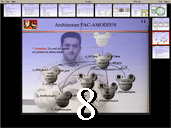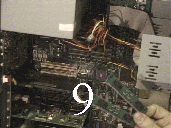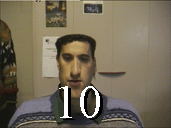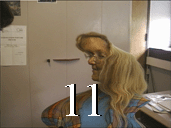General
La même page en Français à propos des Pixels Miroirs
One system, two authors: Christophe Lachenal and Frédéric Vernier.
The Mirror Pixels is a system using the user image in input and output modalities for a smoother interaction between the human and the system.
This system uses a camera (NTSC or PAL) oriented on the user (located on the screen) to simulate the user reflection in the screen
This prototype is under construction and doesn't implement the network functionalities. As you will understand
when seeing the movies, many kind of communications have to be designed.
Movies in Quicktime format and few pictures











-1- The settings of components
Do you see the black camera above the screen ?
-2- User's location
The user takes place in front of the screen, not too close
So the angle between the camera, the user's eye and the user's mirror avatar isn;t too big to avoid the "beaten dog effect"
-3- Image composition
The system merges the working image (desktop image) of the computer and the user reflection (mirror image) by transparency
Our algorithm uses a 32bit shifting (division by 2, 4 or 8, 32 bit masking (getting rid of shifting side effect) and 32 bit
addition (composition of Red, Green and Blue channel in one operation)
-4- 1rst scenario : meteorology presentation
The user doesn't need to handle a blue screen or a feedback screen, everything is done is a single natural mirror metaphor
The user doesn't hide anything as transparency is used. User even sometimes uses their two arms/hands to present. Together or
one just after the other to minimize the gestures.
-5- 2nde scenario : hardware fixing
The user uses his two hands to show the gesture of taking a memory chip by the 4 corners, move the chip to the right location in the
mother board, show a rotation movement to insert the chip and at the end how to push with thumbs to finish the operation. This gesture
would have been impossible to explain by phone or with a simple mouse over the picture.
-6- 3th scenario : remote software learning
My mother has problem inserting a picture in her word document. She presses the F13 key and her son appears in transparency inside her
screen. In fact her son receives the VNC like remote desktop of his mum and apply the pixel mirror over it. The resulting image is sent
back to his mother in real time. With his fingers he shows what icon to drag, circle icons and show his agreement/disagreement by facial
expressions. His mother has to click/drad/drop herself the document following her son's fingers so she better learn than waiting for her
son to take control of her computer.
-7- 4th scenario : with a different setting, drawing
Aimong the camera at a blank sheet of paper the user draw on it while looking at the screen instead of his hand. When pleased with a
stroke, he digitalize the ink and use a new piece of paper. The digitalized ink can be re-colored afterward.
-8- 5th scenario : Defending my PhD Thesis (Yes, I really did it).
Using thumbnail of slides on the borders (my final defense took more than 25 slides) surrounding the mirrored current slide. The same
thing is shown by the defender on his screen and on the wall. On graphical slides I use my two hands at the same time to show pieces
of diagram working together. The mirror can be activated or not on each slide.
-9- Hardware picture.
This maybe may be usefull to understand the 2nde scenario .
-10- Grimace (ME).
At late one night I encoutered a bug, my mirror froze line by line in approx 20s. After this time my beautifull live mirror
was a still image but the image was built of line from differnet times. 1/25th s between 2 lines on 480 lines. The still
background isn't affected but any moving thing in the field of view of the camera is distorted like a funny house mirror.
People could't stop playing with with nice toy. I have hundreds of picture like this with most of my friends. There are
an infinite number of possibilities and it is impossible to retake a picture. In this one I look like Mr Silvestre of
Guignols de l'info
-11- Grimace (Joelle Coutaz) .
I thought my mirror pixels interface was the most natural but the grimace one is een better. You don't even need to understand
the mirror effect, just move if you want ! ... but the half mirror part of the interface is very usefull to control the grimace
you are doing while doing it. IT IS AN INTERACTIVE ARTISTIC APPLICATION or a Computer Assisted Grimage (CAG) according to your
goals. The art picture of Joelle is so like a Picasso cubistic painting !
To do
Network transmission of the video. Inteligent compression for face/body distinction
push-to-talk voice messages with video synchronization
Fake Transparency-screen for small object manipulation and repair
USB and firewire video cameras (webcams like)
Acknowlegments
David Thevenin who bring his knowledge on cleaning algorithm
Joelle Coutaz et Laurence Nigay (our supervisors) who support the idea and bring it to the implementation
|





















